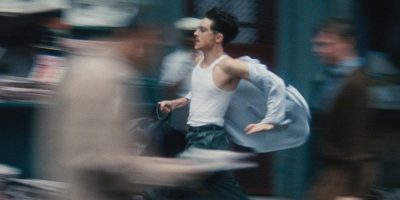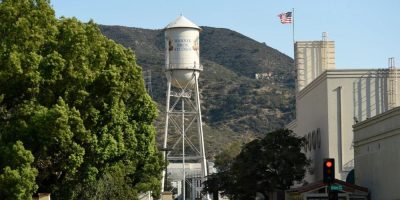
As the Teenage Mutant Ninja Turtles grew to become a pop culture sensation, the place where they were conceived rarely got mentioned.
It wasn't the New York City sewers, where the Turtles mutated from regular reptiles into a crime-fighting quartet who battled foes with nunchucks, snark and pizza. Rather, it was a small city near the New Hampshire coast.
A new exhibit hopes to put that community, Dover, New Hampshire, at the center of the Turtles' story and, in turn, attract Turtle-obsessed fans or anyone else who grew up reading the comics and watching Ninja Turtles movies and TV shows. At one point in the 1980s, the frenzy around the Turtles was called Turtlemania.
“It's the birthplace,” said Kevin Eastman, who, along with Peter Laird, created the Teenage Mutant Ninja Turtles 41 years ago when the two shared a house in Dover. The first issue went on sale a year later. “That’s where the Turtles were created. ... It is very historic and very important to us.”
The Turtles' exhibit opened last month at the Woodman Museum, which houses an eclectic collection that includes a stuffed polar bear and a Victorian funeral exhibit replete with a horse-drawn hearse.
With its explosion of colours and cabinets full of action figures, the exhibit aims to be the place to go for all things Turtles.
It starts with the franchise's humble beginnings in Dover, where the duo formed Mirage Studios, a play on the fact they were creating the first comic in their living room rather than an actual studio. Inspired by Eastman's fascination with turtles and martial arts, they came up with the crime-fighting Turtles and self-published their first comic in black and white.
“We hoped that one day we would sell enough copies of our 3,000 printed, $1.50 comic books that we could pay my uncle back,” Eastman said, adding that they had no intention of writing a second issue until fans asked for more.
“We loved our characters. We loved what we did. We told the best story we could. We hoped for the best,” he continued. “But I also could never have imagined that one comic book would lead to any of this.”
Barrie's News Delivered To Your Inbox
By submitting this form, you are consenting to receive marketing emails from: Central Ontario Broadcasting, 431 Huronia Rd, Barrie, Ontario, CA, https://www.cobroadcasting.com. You can revoke your consent to receive emails at any time by using the SafeUnsubscribe® link, found at the bottom of every email. Emails are serviced by Constant Contact
Ralph DiBernardo, whose store in nearby Rochester sells comics and games, was among the first to champion the Turtles. He knew Eastman and Laird from selling them comics and was the first person to sell their Turtles comic commercially after purchasing 500 copies. But he said at the time, it seemed more like a favor to friends than a business decision, with him thinking, “those guys are never going to make their money back.”
“To watch them go from two struggling guys just barely getting by to becoming multi-millionaires, it’s that American dream story that just never happens,” said DiBernardo, who remains friends with the two artists.
The exhibit details the emergence of the Turtles as a global phenomenon, featuring pizza-obsessed characters with catchphrases such as “cowabunga” and “booyakasha.”
Among the exhibit's highlights are a video game console where visitors can play Turtles arcade games, vinyl records of soundtracks from Turtles movies and signed, first-run Turtles comics, including some valued in the tens of thousands of dollars. The marketing power of the Turtles is also on display, with everything from Turtles-inspired Christmas ornaments, throw rugs and backpacks to a talking toothbrush.
In the middle of it all is a set of massive bronze statues depicting the four turtles — Leonardo, Michelangelo, Donatello and Raphael — along with the mutant rat and resident sage, Master Splinter. The display was one of 12 made as part of a fundraiser by Eastman to benefit a museum in Northampton, Massachusetts.
“The Ninja Turtles are a multi-billion-dollar international franchise, and they originated here in Dover,” said Jonathan Nichols, the executive director of the Woodman Museum. “So, it was a no-brainer for us to incorporate the Ninja Turtles here. This gallery is really a celebration and the history of the turtles from their creation to today.”
Eastman said the exhibit demonstrates the Turtles' widespread appeal, which he attributes to their heroic natures and that they operate almost like a family that bickers but also works better as a team. Fans also love that they are “four green, mutated turtles not of any race, creed or colour.”
“Anybody could be a Turtle,” said Eastman, who now lives in Arizona but plans to attend a Manchester, New Hampshire, comic convention later this month. He said he loves “talking to the fans not only about what they love about their Turtle,” but also “what their favorite Turtle is.”
“I ask who they relate to. It tells a lot about their personality,” he added.
The exhibit's opening is part of a larger effort, some say long overdue, by Dover to embrace the Turtles. A state historical marker went up next door to the museum last year recognizing Dover as the birthplace of the Ninja Turtles. A few blocks away, a decorative manhole was placed in front of an empty lot where the creators' house once stood.
“I grew up here in Dover and had no idea that I was actually growing up in the town where they were created,” Nichols said. “So, once that really started being brought to the forefront, I think it was just a huge push in the town to really make that well known.”
Nichols said he has had a few super fans already visit decked out in Turtles' attire. But the other day, the exhibit was drawing visitors who had come to see other parts of the museum and found themselves going down memory lane with the Turtles.
“Just memories of the Turtles eating pizza,” said Heidi Stephenson, who was visiting with her family from Canada.
David Sarge, a cook from Pennsylvania who was an avid comic book collector as a teenager, said the exhibit brought back memories of attending a Portsmouth, New Hampshire, comic convention where the first comic was sold. He purchased signed editions of the first two Turtles comics but allowed youthful exuberance to get in the way of what could eventually may have been a big payday.
“I traded them shortly thereafter for some reefer and I regret that to this day,” he said with a laugh.




